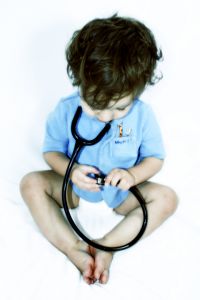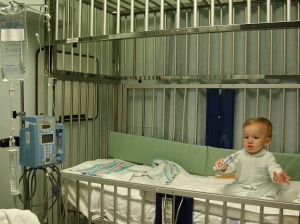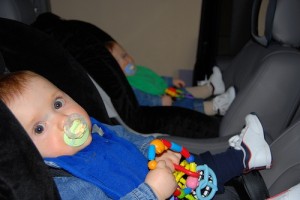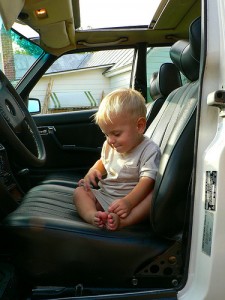
 Health insurance is a hot topic in the US right now. While congress debates the topic, I thought I’d share an option some families have that many are unaware of to insure their children. Most people are aware of Medicaid, a government run health care option for low income families. Many people do not qualify for Medicaid due to the income and financial guidelines. However, every state in the US has ”Medicaid Waivers” that allows certain individuals who do not qualify based on financial criteria to participate in Medicaid through these waiver programs. Typically, for a child to qualify for Medicaid, the government will evaluate the family’s income and assets to determine eligibility. Medicaid waivers evaluate the individual’s income and assets to determine eligibility and does not consider the parents’ income and assets. In other words, my daughter qualifies for Medicaid through a waiver based on HER income and assets and our total family income and assets are not factored into her eligibility determination. The waiver is offered to different populations of people. Some state Medicaid waivers are offered to individuals based on their intelligience quotient. Some state Medicaid waivers are offered to individuals based on their medical issues and health.
Health insurance is a hot topic in the US right now. While congress debates the topic, I thought I’d share an option some families have that many are unaware of to insure their children. Most people are aware of Medicaid, a government run health care option for low income families. Many people do not qualify for Medicaid due to the income and financial guidelines. However, every state in the US has ”Medicaid Waivers” that allows certain individuals who do not qualify based on financial criteria to participate in Medicaid through these waiver programs. Typically, for a child to qualify for Medicaid, the government will evaluate the family’s income and assets to determine eligibility. Medicaid waivers evaluate the individual’s income and assets to determine eligibility and does not consider the parents’ income and assets. In other words, my daughter qualifies for Medicaid through a waiver based on HER income and assets and our total family income and assets are not factored into her eligibility determination. The waiver is offered to different populations of people. Some state Medicaid waivers are offered to individuals based on their intelligience quotient. Some state Medicaid waivers are offered to individuals based on their medical issues and health.
Every state is very different in how they run their Medicaid waiver programs and every state offers different benefits outside of Medicaid to their waiver participants. So, to keep my dear readers from becoming too confused, I am going to share with you how one Texas Medicaid waiver works. Keep in mind, in the state of Texas, there are actually many different waiver programs that all are slightly different from one another, however a basic understanding of one of these waivers will give you a general idea of how Medicaid waivers work.
My daughter is on the Medically-Dependent-Children’s-Program Medicaid Waiver (AKA: MDCP). When she was a few months old, I put her on an interest list, which is basically a waiting list to be evaluated for eligibility for MDCP. It was very easy to add her to the interest list and I called religiously every month to see where she was on the list. A month before her third birthday, I received a phone call from MDCP stating my daughter had come up on the interest list. We set up an evaluation in my home and she qualified for the MDCP Medicaid waiver due to her health issues and medications. We chose to keep our primary health insurance for her and she started receiving Medicaid as a supplemental health insurance, so we no longer had to pay for her deductibles, co-pays, prescriptions, cost-shares, or any other health related expense. Her MDCP Medicaid waiver also brought along several other benefits, including:
- MDCP pays a portion of our primary health insurance premium. It is cheaper for Medicaid to be a supplemental health insurance, so as an incentive for us to keep her on our family’s primary health insurance, we are reimbursed a portion of our monthly premiums.
- MDCP provides respite. Due to her health care needs, she needs to be left with caregivers who are aware of her health issues, medications, and special needs. MDCP pays a person who we have hired to take care of my daughter in our home. This has been a huge blessing for my family. We were able to hire a person we trust to take care of her when we needed someone to watch her and are confident that if she needs any medical attention, that person will be able to take the proper steps necessary.
- Her waiver provides medical equipment and supplies that are not otherwise covered by health insurance. My daughter is almost five and is still not potty trained. Her waiver provides diapers and supplies for her.
- Her waiver provides transportation or mileage reimbursement for the many doctor and therapy appointments she has every week.
A lot of states, but not all, have waiting lists for their Medicaid waiver programs. To see what types of Medicaid waivers are offered in your state, click here: http://www.cms.hhs.gov/MedicaidStWaivProgDemoPGI/08_WavMap.asp When you click on your state, a list of waivers will pop up. The state of Texas has 25 waiver programs. You may need to scroll to another page to see all the waiver programs in your state. When you select a program, you will have the option to download the very long and confusing program description. I suggest, instead, contacting or looking up your state’s Department of Aging and Disabilities website to find more information (in layman’s terms) about your state’s waiver programs and process of applying. Medicaid waivers can be very difficult to navigate, but very beneficial to families who have children with a lot of medical issues or families who need respite care due to their child’s higher level of needs.

 Last Friday, my 18 month old daughter had her cleft palate repaired and we stayed two nights in the hospital. Due to various medical issues with my children, I’ve spent my share of nights sleeping on pull-out hospital beds and have learned that staying in the hospital is probably one of the most uncomfortable places to stay. I have written an article to help parents prepare for their child’s surgery and now have decided that parents also need some encouragement on finding ways to be more comfortable during their hospital stay with their child. Simple things, like knowing how to silence the iv machine alarm can really make a big difference during your child’s stay. I’ve also stopped being afraid of bothering the nurses when my child or I need something.
Last Friday, my 18 month old daughter had her cleft palate repaired and we stayed two nights in the hospital. Due to various medical issues with my children, I’ve spent my share of nights sleeping on pull-out hospital beds and have learned that staying in the hospital is probably one of the most uncomfortable places to stay. I have written an article to help parents prepare for their child’s surgery and now have decided that parents also need some encouragement on finding ways to be more comfortable during their hospital stay with their child. Simple things, like knowing how to silence the iv machine alarm can really make a big difference during your child’s stay. I’ve also stopped being afraid of bothering the nurses when my child or I need something.
Here are 10 ways to make your hospital stay a little more comfortable:
- Go home to shower and get a couple hour nap or break if possible. Allow a friend or family member to stay with your child while they are resting while you go home and recuperate a little.
- Learn how to silence the alarms on those machines. Once you’ve paged your nurse that their iv pole bag is empty, there is no need for you to endure the loud, annoying beeping that accompanies the empty iv pole bag.
- Bring a portable DVD player with headphones and rent a good chick flick.
- Don’t be afraid to ask your nurse for things you need (like a rocker, extra pillows, to start the coffee maker in the family kitchen, etc…) and more importantly, keep asking until you get it!
- If you think your child needs pain medicine, then communicate that to your nurse. I have felt at times like I sounded like I was overly drug-seeking for pain medicine for my child, but staying ahead of the pain after surgery can be the difference of being slightly uncomfortable and completely miserable during your hospital stay. If the pain medicine is not working, ask your nurse to page your doctor to see if there is something else you can try.
- Make friends with your child’s roommate. Conversations with other parents can really help the time to go by quicker.
- If you’re not happy with your nurse, ask to speak to the charge nurse to share your concerns.
- On the flip side, make sure you let the charge nurse know when you have a fantastic nurse! We had the best nurses we’ve ever had this past weekend and was sure to let the charge nurse know what fantastic nurses we had this weekend and named them to her.
- Don’t feel the need to get up when the nurse comes in your room in the middle of the night to check vital signs or mess with the iv pole. If your child does not need you to tend to her, keep getting as much sleep as you can!
- Ask questions about the care your child is receiving. Learn the dosages of your child’s medication and/or special precautions that should be taken with your child while recovering in the hospital. We have had a couple of incidences with improper dosages and medications with our children which were caught because I was aware of their medication.
What are some ways you have become more comfortable during your child’s hospital stay?

 Should you keep your child in a rear facing car seat past the minimum requirement? The American Academy of Pediatrics currently recommends that “children should face the rear of the vehicle until they are at least 1 year of age and weigh at least 20 lb to decrease the risk of cervical spine injury in the event of a crash.”
Should you keep your child in a rear facing car seat past the minimum requirement? The American Academy of Pediatrics currently recommends that “children should face the rear of the vehicle until they are at least 1 year of age and weigh at least 20 lb to decrease the risk of cervical spine injury in the event of a crash.”
Last month the British Medical Journal published an article stating that “rear facing seats are safer than forward facing seats for children under 4 years old.” So parents should keep young children in rear facing seats as long as possible. The report goes on to say that “excessive stretching or even transection of the spinal cord can result if a child is involved in a head-on crash while in a forward facing car seat.”
Car-safety.org explains that “rear-facing car seats spread frontal crash forces over the whole area of a child’s back, head and neck; they also prevent the head from snapping relative to the body in a frontal crash.”
In an article for ABC News Sharon Munns, injury prevention coordinator at the Mayo Clinic Trauma Center in Rochester, Minn. explains the benefits in more detail, “The rear harness works in a way that allows the head, neck, and spine to move all straight up and down, so the body moves with the restraint of the seat, preventing crash-related injuries,” she said. “In a front-facing seating, all of the body weight is going forward on the harness, which can cause injury to the head, neck and spine for children under 35 pounds. There are documents of spinal cord injuries because of children facing frontward at such an early age.”
(more…)

 This weekend one of my closest friends accidentally locked her 21-month old daughter in her Jeep Liberty. Thankfully after the police and a fire truck came they were able to bust out the back window and get into the vehicle. Her daughter was red and upset, but she eventually calmed down and was fine. My friend had to the endure the embarrassment of the situation. This happens to a lot of moms. We don’t intentionally lock our kids in the car, it happens.
This weekend one of my closest friends accidentally locked her 21-month old daughter in her Jeep Liberty. Thankfully after the police and a fire truck came they were able to bust out the back window and get into the vehicle. Her daughter was red and upset, but she eventually calmed down and was fine. My friend had to the endure the embarrassment of the situation. This happens to a lot of moms. We don’t intentionally lock our kids in the car, it happens.
I accidentally locked my daughter in the car when she was 18 months old at the grocery store. I set my keys down on the back seat next to her car seat and turned to put the diaper bag on the top of my trunk. Just as I was placing the bag down a gust of wind blew my car door shut. I immediately asked myself how long is she safe in the car with no AC. Thankfully my phone was in the diaper bag and I called my husband. He didn’t answer and I texted the words “call me now!” He had an extra key and was only 3 minutes away at home. While waiting for husband to come I knocked on the window and smiled at her and tried to show her that everything was okay.
Since locking my girl in the car I have started to put the keys on top of my car or in my pocket when I am getting them out. Another way to prevent the situation is to carry an extra key hidden on the car under the license plate or taped under the car somewhere. Pop A Lock will also open your car for free. You can program the number of your local dispatch in your phone. (I just programmed mine. It took less than 60 seconds.)
In this summer heat the temperature of the inside of the car can rise significantly in just a few minutes. Here is an excellent post on Baby Tool Kit about what do when an infant or child is accidentally locked in a car with the keys. The first thing is not to panic and then call for help. If you don’t have a phone then ask someone nearby to call 911. Then note the time, because sometimes 5 minutes can seem like an eternity.
Locking your child in the car can totally shake you up. Hug your child and get something to drink to hydrate everyone. Be sure you are calm before you drive again. Know that you haven’t lost your card to The World’s Best Moms Club. You are still a great mom!
Have you ever accidentally locked you children in the car? How do you get them out? Where you shaken up?
- photo courtesy of crowdive

 Last week, my son was stung by a wasp on his hand. He didn’t cry and he didn’t have a reaction until about two days later. His entire hand was swollen and red. I called my pediatrician and the nurse told me to just keep an eye on it and to bring him in if it became hot to the touch. It cleared up after about two days of redness and swelling. The day after it cleared up, he was stung by another wasp! (We found the nest and my husband has reclaimed our backyard from those horrible creatures!) Again, we didn’t notice any reaction at all and he didn’t cry or act like it hurt. Two days later, his entire arm was swollen and this time, incredibly hot to the touch. There was a huge red spot covering his entire bicep. While the reaction was similar to the first sting, it was a lot more intense. So, I called the doctor and he wanted me to bring him in. I shamefully told him that my son had been stung by wasps twice in the same week and reassured him we found the nest. The doctor thinks it is at high risk of becoming infected, so we were given instructions to prevent infection, which could turn to a staph infection. I didn’t know that wasp and bee stings could lead to infection. It makes sense when I think about it, but I thought allergic reactions such as breathing difficulty were the only real risk of wasp or bee stings.
Last week, my son was stung by a wasp on his hand. He didn’t cry and he didn’t have a reaction until about two days later. His entire hand was swollen and red. I called my pediatrician and the nurse told me to just keep an eye on it and to bring him in if it became hot to the touch. It cleared up after about two days of redness and swelling. The day after it cleared up, he was stung by another wasp! (We found the nest and my husband has reclaimed our backyard from those horrible creatures!) Again, we didn’t notice any reaction at all and he didn’t cry or act like it hurt. Two days later, his entire arm was swollen and this time, incredibly hot to the touch. There was a huge red spot covering his entire bicep. While the reaction was similar to the first sting, it was a lot more intense. So, I called the doctor and he wanted me to bring him in. I shamefully told him that my son had been stung by wasps twice in the same week and reassured him we found the nest. The doctor thinks it is at high risk of becoming infected, so we were given instructions to prevent infection, which could turn to a staph infection. I didn’t know that wasp and bee stings could lead to infection. It makes sense when I think about it, but I thought allergic reactions such as breathing difficulty were the only real risk of wasp or bee stings.
So, until my son’s boo boo heals, we are to do the following:
- Use ice to relieve pain or discomfort
- Apply hydrocortisone cream to it twice a day
- Take over-the-counter Zyrtec instead of Benedryl because our doctor thinks it works better and my son becomes hyper and wirey on Benedryl, which is opposite most children.
- Clean it twice a day with a clorox/water solution. I have never in my life heard a medical professional direct someone to use clorox bleach, so this was interesting to me.
- Fill a prescription for a steroid cream and have it on hand in case the red spot becomes streaky or asymmetrical and call or take him to the hospital right away.
I initially felt silly even being concerned about my son’s wasp sting, especially since I had already called the pediatrician last week about the same issue. I tend to write off what I consider small medical issues because I have three children who all carry their own set of more major medical issues as it is. But I am glad I listened to my gut that this reaction was worse than last week’s reaction. I have learned in parenting and medical care for my children is that medical professionals are paid by me (and my insurance) to answer my medical questions and treat my children, so I have given up on feeling guilty about using the service that I am paying for. Besides, what a parent may think is minor, may actually end up being serious, so it’s always better safe than sorry!
Have your children had a reaction to bee or wasp stings? Am I the only one whose never heard of cleaning an infected area with a clorox/water solution?

 Health insurance is a hot topic in the US right now. While congress debates the topic, I thought I’d share an option some families have that many are unaware of to insure their children. Most people are aware of Medicaid, a government run health care option for low income families. Many people do not qualify for Medicaid due to the income and financial guidelines. However, every state in the US has ”Medicaid Waivers” that allows certain individuals who do not qualify based on financial criteria to participate in Medicaid through these waiver programs. Typically, for a child to qualify for Medicaid, the government will evaluate the family’s income and assets to determine eligibility. Medicaid waivers evaluate the individual’s income and assets to determine eligibility and does not consider the parents’ income and assets. In other words, my daughter qualifies for Medicaid through a waiver based on HER income and assets and our total family income and assets are not factored into her eligibility determination. The waiver is offered to different populations of people. Some state Medicaid waivers are offered to individuals based on their intelligience quotient. Some state Medicaid waivers are offered to individuals based on their medical issues and health.
Health insurance is a hot topic in the US right now. While congress debates the topic, I thought I’d share an option some families have that many are unaware of to insure their children. Most people are aware of Medicaid, a government run health care option for low income families. Many people do not qualify for Medicaid due to the income and financial guidelines. However, every state in the US has ”Medicaid Waivers” that allows certain individuals who do not qualify based on financial criteria to participate in Medicaid through these waiver programs. Typically, for a child to qualify for Medicaid, the government will evaluate the family’s income and assets to determine eligibility. Medicaid waivers evaluate the individual’s income and assets to determine eligibility and does not consider the parents’ income and assets. In other words, my daughter qualifies for Medicaid through a waiver based on HER income and assets and our total family income and assets are not factored into her eligibility determination. The waiver is offered to different populations of people. Some state Medicaid waivers are offered to individuals based on their intelligience quotient. Some state Medicaid waivers are offered to individuals based on their medical issues and health.
 Last Friday, my 18 month old daughter had her cleft palate repaired and we stayed two nights in the hospital. Due to various medical issues with my children, I’ve spent my share of nights sleeping on pull-out hospital beds and have learned that staying in the hospital is probably one of the most uncomfortable places to stay. I have
Last Friday, my 18 month old daughter had her cleft palate repaired and we stayed two nights in the hospital. Due to various medical issues with my children, I’ve spent my share of nights sleeping on pull-out hospital beds and have learned that staying in the hospital is probably one of the most uncomfortable places to stay. I have 
 Should you keep your child in a rear facing car seat past the minimum requirement? The
Should you keep your child in a rear facing car seat past the minimum requirement? The  This weekend one of my closest friends accidentally locked her 21-month old daughter in her Jeep Liberty. Thankfully after the police and a fire truck came they were able to bust out the back window and get into the vehicle. Her daughter was red and upset, but she eventually calmed down and was fine. My friend had to the endure the embarrassment of the situation.
This weekend one of my closest friends accidentally locked her 21-month old daughter in her Jeep Liberty. Thankfully after the police and a fire truck came they were able to bust out the back window and get into the vehicle. Her daughter was red and upset, but she eventually calmed down and was fine. My friend had to the endure the embarrassment of the situation.  Last week, my son was stung by a wasp on his hand. He didn’t cry and he didn’t have a reaction until about two days later. His entire hand was swollen and red. I called my pediatrician and the nurse told me to just keep an eye on it and to bring him in if it became hot to the touch. It cleared up after about two days of redness and swelling. The day after it cleared up, he was stung by another wasp! (We found the nest and my husband has reclaimed our backyard from those horrible creatures!) Again, we didn’t notice any reaction at all and he didn’t cry or act like it hurt. Two days later, his entire arm was swollen and this time, incredibly hot to the touch. There was a huge red spot covering his entire bicep. While the reaction was similar to the first sting, it was a lot more intense. So, I called the doctor and he wanted me to bring him in. I shamefully told him that my son had been stung by wasps twice in the same week and reassured him we found the nest. The doctor thinks it is at high risk of becoming infected, so we were given instructions to prevent infection, which could turn to a staph infection. I didn’t know that wasp and bee stings could lead to infection. It makes sense when I think about it, but I thought allergic reactions such as breathing difficulty were the only real risk of wasp or bee stings.
Last week, my son was stung by a wasp on his hand. He didn’t cry and he didn’t have a reaction until about two days later. His entire hand was swollen and red. I called my pediatrician and the nurse told me to just keep an eye on it and to bring him in if it became hot to the touch. It cleared up after about two days of redness and swelling. The day after it cleared up, he was stung by another wasp! (We found the nest and my husband has reclaimed our backyard from those horrible creatures!) Again, we didn’t notice any reaction at all and he didn’t cry or act like it hurt. Two days later, his entire arm was swollen and this time, incredibly hot to the touch. There was a huge red spot covering his entire bicep. While the reaction was similar to the first sting, it was a lot more intense. So, I called the doctor and he wanted me to bring him in. I shamefully told him that my son had been stung by wasps twice in the same week and reassured him we found the nest. The doctor thinks it is at high risk of becoming infected, so we were given instructions to prevent infection, which could turn to a staph infection. I didn’t know that wasp and bee stings could lead to infection. It makes sense when I think about it, but I thought allergic reactions such as breathing difficulty were the only real risk of wasp or bee stings.



